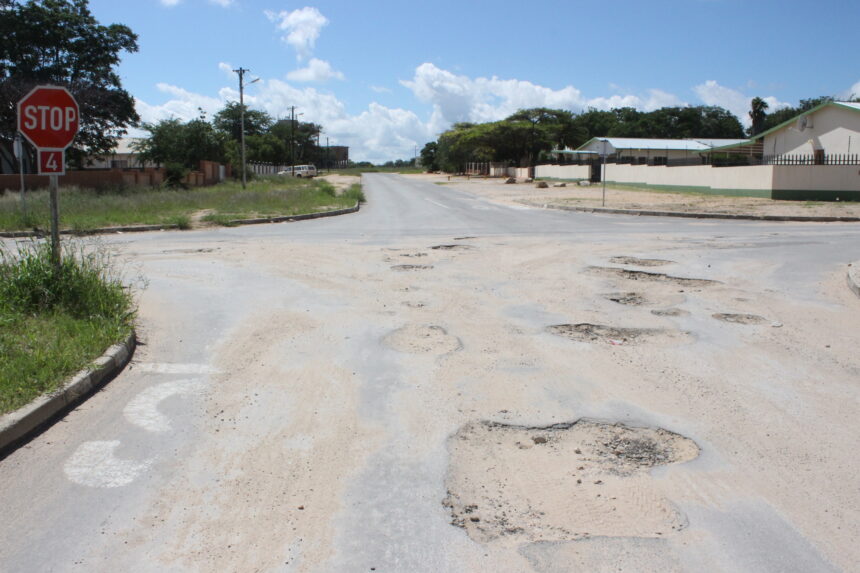WALVIS BAY – Namibia requires about N$5 billion annually to effectively maintain its national roads network.
Road Fund Administration (RFA) CEO Ali Ipinge stated on Thursday that roads maintenance is quite a challenge due to limited available funding.
He was speaking in Walvis Bay last
week, where the RFA injected over N$250 million to rehabilitate key economic roads on which cargo is transported to and from Namport.
The RFA currently generates around N$3.5 billion annually, which results in a significant shortfall, compared to what is needed for roads rehabilitation. They generate revenue primarily through fuel levies, which are charges added to every litre of fuel sold. This revenue constitutes the RFA’s largest source of funding, directly supporting the maintenance and rehabilitation of national roads.
“We requested a N$1 increase on the fuel levy, which would generate an additional
N$1 billion to help fund roadworks in Walvis Bay and other municipalities. While some argue that this is a lot of money, maintaining roads is costly,” he emphasised.
The recently-approved N$0.25 fuel levy increase will assist in addressing this shortfall, but he admitted that it still leaves a gap in necessary funding. “Without adequate contributions, towns and cities across Namibia will continue to struggle with deteriorating roads, making it difficult to maintain essential infrastructure,” Ipinge stated.
Maintenance plan
He noted that the cost of roads rehabilitation, especially in towns such as Walvis Bay, is exacerbated by the lack of a maintenance plan.
“The maintenance of roads is a challenge not only in Walvis Bay, but countrywide. We are looking at alternative ways of supporting local authorities with effective road maintenance strategies, and to collaborate on how we can ensure that our urban roads and streets do not deteriorate due to the lack of effective maintenance strategies,” he continued.
He noted that Walvis Bay’s situation of potholes and deteriorating roads is a lack of proper planning and effective maintenance which has culminated over the years.
“Hence, going forward, we are committing to ensuring that there is an effective maintenance strategy for urban roads and streets countrywide,” he said. Also speaking at the event, works deputy minister Veikko Nekundi highlighted the poor condition of some of the key roads in Walvis Bay, which is an essential trade hub for southern Africa. The harbour town is grappling with road conditions worsened by a surge in heavy commercial vehicles accessing the port. “Several streets, including 18th Street, are in an extremely poor condition. These roads were not originally designed to sustain the current level of heavy traffic, which has led to increased travel times, pollution and overall deterioration,” he said.
He added that the upgrading of 18 roads in Walvis Bay is highly appreciated by the government. “The diversion of trade due to poor road conditions could harm Namibia’s economy and livelihoods. We cannot let this happen,” he cautioned. Erongo governor Neville Andre pointed out the strategic importance of Walvis Bay’s infrastructure, noting that the rehabilitation project would benefit residents and the broader national economy. “The rehabilitation of our streets will not only improve the daily lives of our citizens, but also strengthen our position as a key player in the trade corridors that connect us to the world,” he observed. The N$250 million project, to be carried out by Otesa Civil Engineering with supervision from Tulipamwe Consulting Engineers, is expected to improve road safety by upgrading intersection layouts, reducing congestion, and decreasing motor-vehicle accidents.
The Walvis Bay council is expected to rehabilitate the remaining roads in poor condition in the town by themselves.
The town has a total length of about 190 kilometres (km) of tarred roads, and 50km of gravel roads. The RFA has in the past touted toll gates on strategic roads as a possible revenue-generating solution to maintain the national roads network. The alternative, the RFA cautioned, would be a continued rapid deterioration of the national roads infrastructure.
At previous presentations, Ipinge warned that national roads infrastructure is ageing, and that the gap between what is required at the optimum level and what is being generated from the road user charges is not sufficient.
“The gap is widening, and we are seeing that over the next five years, we will only be able to effectively provide funding up to the level of 60%. So, we have to look at alternative funding streams,” he remarked earlier this year.
A 2023 report noted that should toll gates become a reality in Namibia, the average toll would range from N$19.26 for passenger vehicles to N$83.08 across all sections.
However, the actual toll fee would be determined primarily by traffic volumes, length of the road, and cost of capital investment.



